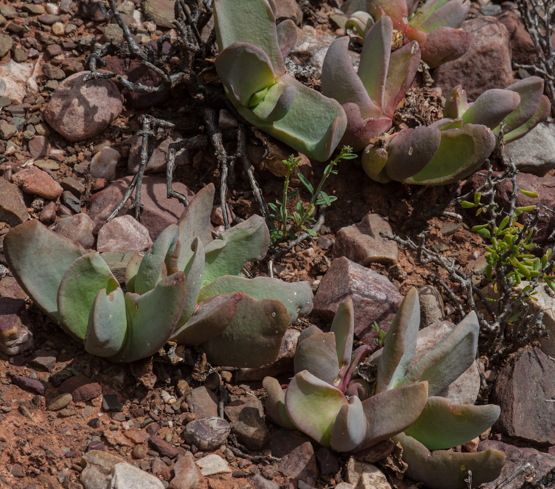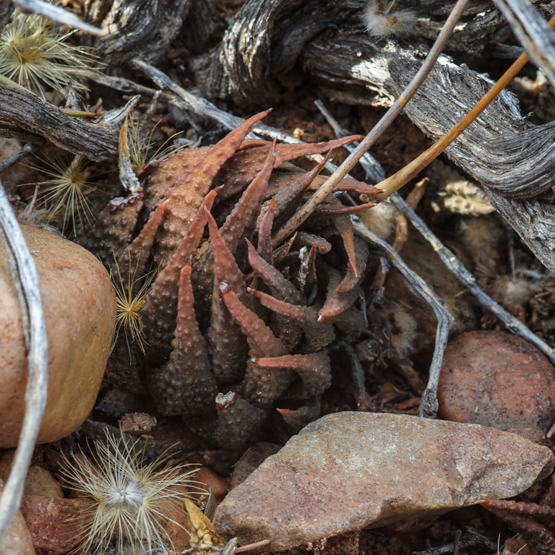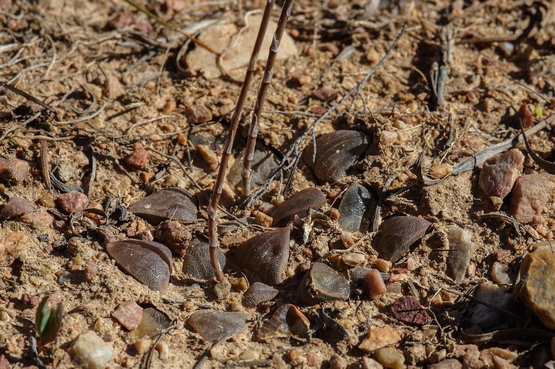Although rather variable, this species is easy to identify (H. nigra is the only other Haworthia in which the leaves are arranged in three ranks). The species is tall as Haworthias go: up to 30 cm. It is widely distributed from halfway between Laingsburg and Sutherland, throughout the central, eastern and southern Karoo and the Little Karoo, with an outlying habitat near Graaff-Reinet. In shade the plants are green, but one often encounters them in very arid places in full sun, where they usually become brownish, reddish or orange.
Tag: Little Karoo
Gibbaeum nuciforme 2
Gibbaeum nuciforme (G. cryptopodium) 1
A widely distributed species (from Zebra, between George and Oudtshoorn, to the Montagu area), often locally abundant on loamy soils with quartz pebbles.
The very soft, almost translucent bodies lie flat on the ground (cryptopodium literally means “with hidden foot”) and in dry periods often almost disappear from sight. In the rainy season they are yellowish green, often turning red in the dry period. They are more or less round or egg-shaped (nuciforme = shaped like a nut).
To be continued.
Octopoma quadrisepalum
Although this species and its sibling O. octojuge (see post 16 June this year) have the same general distribution area (Laingsburg, Ladismith and Swellendam), they never seem to grow together. It is a pity one does not see them in cultivation more often, as both are nice little shrubs (not more than 10 cm tall), with relatively big flowers. The photos were taken northeast of Montagu on the road to Anysberg on 30 October 2013. In the first picture you will also see Gibbaeum nuciforme.
Anacampseros arachnoides
It is easy to take this species for granted, even in spite of the cobwebby hairs it is decorated with.
The following is a quote from Gordon Rowley’s booklet ” Anacampseros, Avonia, Grahamia. A grower’s Handbook” :
“This attractive and distinctive species seeds itself freely around the glasshouse and has long been cherished or tolerated in collections of succulents. The abrupt tapering of the leaf to a spiny tip is its most distinctive feature”
This sounds to me like a nice example of damning with faint praise.
When one inspects the plants a bit closer, the beautiful, almost reptile-like surface texture of the leaves is revealed. I must confess that since I have discovered this characteristic, I look at these plants with renewed respect.
Glottiphyllum linguiforme
Another peculiar name: both glottis and lingua mean tongue, phyllum = leaf and forme = yes, indeed. So, in other words: the tongue leaf with the tongue shape.
The plants occur in the Oudtshoorn-Calitzdorp area, where the rainfall is 100-200 mm per year. They usually grow under shrubs on loamy or sandy soil with some quartzite and flower in late autumn and winter (March-June).
Haworthia scabra v. scabra
Trichodiadema attonsum
We often refer to scientific names in biology as Latin names, because most of them are either derived from that language or are latinised from other languages. If that were the case here too, the second part of the name should be attonsa. The name Trichodiadema is however derived from Greek (thrix = hair and diadema = crown) and because diadema is a neuter word, the second part of the name has to be attonsum.
As the name implies, most species of Trichodiadema have a crown of hairs at the top of the leaves. The word attonsum means shaved or pruned and is quite appropriate, because this species lacks the diadema that is so characteristic for most other members of the genus.
According to the literature the species occurs on rocky outcrops, as shown in the first two pictures, taken on the Rooiberg near Calitzdorp (23 Oct. 2009).
The third picture was taken 2 days ago, near the southwestern border of Anysberg Nature Reserve. Although the plant clearly does not grow on an outcrop of any kind, there are quartz pebbles present.
Haworthia bayeri
This beautiful species occurs from near Willowmore to just west of Oudtshoorn.
Unfortunately, the place near De Rust where these pictures were taken is now almost completely stripped of this and other interesting succulents. A result of plain unadulterated greed!
The first four pictures were taken between 18 and 28 Sept., the other two 20 Nov.
Glottiphyllum fergusoniae (2)
I lied to you yesterday. Not on purpose, but as a result of sloppiness. Sorry, sorry.
I told you I had never before seen Glottiphyllum fergusoniae in the wild, but in the meantime I found out that this is not true. When I published my post yesterday, I did not think too much of it. Actually I had been working on another subject, but that took much more time then I had envisaged, so I decided to follow the easy route and just publish a few recent pictures with little commentary.
Much to my surprise a lot of people apparently liked the post, which in turn prompted me to have another look at the pictures. Then it dawned upon me that I had seen similar plants in late June this year. Because I still lived in Calitzdorp at the time, I came from the east, which fact supposedly prevented me from making the mental connection. Looking at the map it became clear that the two localities involved are only about 40 kms apart. I had ID’ed the June plants as G. surrectum, but in hindsight I did not pay proper attention to the fact that the leaves in that species are distichous (in two opposite rows) rather than decussate (in crossed pairs).
The following pictures show you plants from the eastern locality.
















































